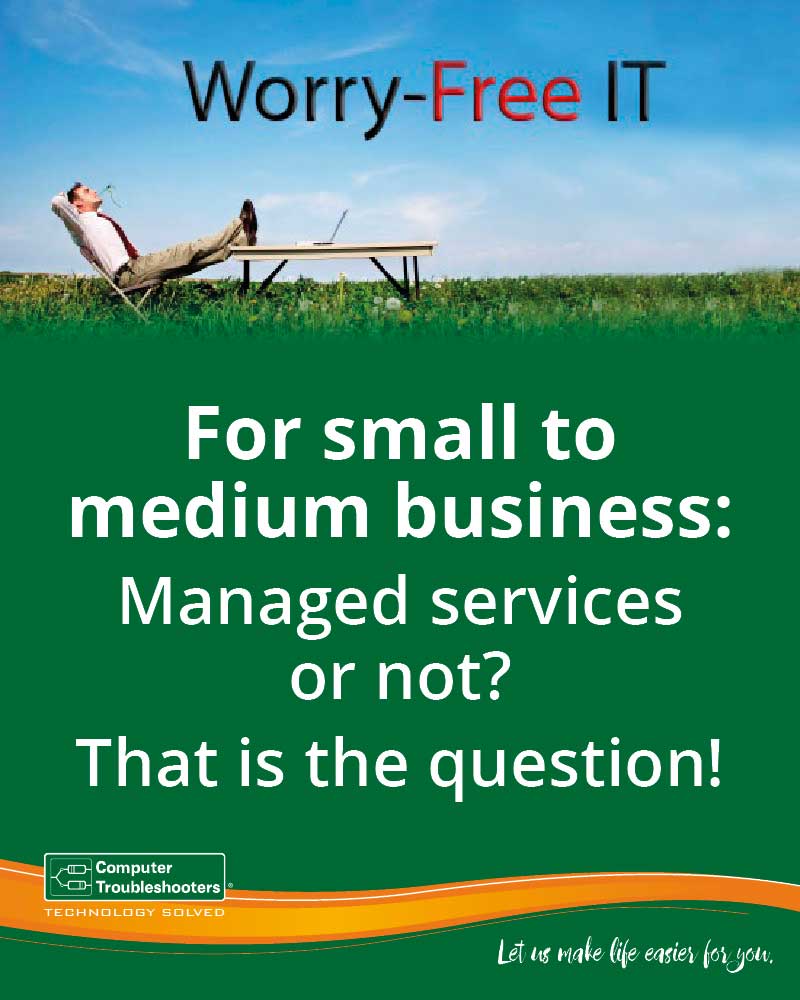For Small to Medium Business: To Managed services or not?
Too many small to medium business owners increase the risk to their survival by being reactive rather than being proactive in managing their IT infrastructure, hardware, software, usage of cloud services, smartphones and the internet.
One must ask the question why? The answer has a variety of answers. Some of it is because that’s the way we have always done it, sometimes it’s a lack of understanding of how reliant small to medium businesses have become on IT, however the main reason is an attitude around perceived cost. Yes, they see managing IT proactively as, not delivering a return on investment but rather, a cost that reduces the bottom line.
The key considerations for small to medium business owners is to understand that being reactive is more expensive than taking a proactive prevention approach to the management of IT. Why? because every minute of downtime is costing a business, it is not only the direct cost of the technician and his time but also the time the businesses employees are being unproductive and the cost of not being able to respond to customers. Poor response time and lack of availability of your technician combined with the unexpected cost of replacing equipment impact the viability of the reactive IT management model.
Can this be avoided?
The simple answer is yes, which raises the question of how? Again, the answer is an easy one for small to medium businesses by investigating the option of outsourcing the management of their IT under a managed services agreement to an IT service provider like Computer Troubleshooters.
The challenge for many small to medium business owners is to make sure they have a process that answers questions such as; having a defined selection criteria, clear articulation of their needs and what needs to be managed, clear understanding of the costs and what is covered and not covered by the agreement, ensuring there is clarity around the key deliverables for the small to medium business. This article aims to help you in developing that process.
What are the steps involved in selecting a provider?
Like any exercise a small to medium business owner needs to plan and have a structured process otherwise you increase the risk of making a bad decision.
Commence by understanding what you need in terms of services and the type of company that you are looking for. As an example, do you need your applications (accounting software, Office 365) to be managed or is it just making sure that you are fully protected against cyber threats? Is it managing passwords and ensuring email is available 24/7, or does it include patch management, ensuring your data is being backed-up regularly and being notified when a back-up fails or does it include making sure the network is running at an optimum level?
Start by identifying what is critical to your business and set that as the original scope. At the end of the initial contract period review and expand the scope if you are satisfied with the service.
Develop a selection criteria that includes the concept of value for money when selecting a provider. Remember selecting the cheapest price option is not necessarily the best result for you. Talk to some of the provider’s customer to establish their capability to deliver on what they are promising.
A guiding principle should be ensuring that your provider has the right people with the right skills doing the right things using the right tools to deliver the service.
Factors to consider are:
- experience of the provider, customer base who they work for, industries, size of businesses
- flexibility and capacity to adapt as your needs change
- capacity to respond, hours of operation, do they have a NOC centre
- their technology and the skill set of the provider and knowledge including emerging technologies such as cloud services
- pricing, what is included and excluded from the plan, termination process of contract.
One last factor to consider is the way the provider manages the relationship and the way they interact with you and the frequency they are providing updates to you. Ensure you have a set of performance indicators by which you will judge the performance of the Managed Service Provider.
What does a managed service plan look like?
The first element to look at is how the provider charges for their services. There is a variety of models with the most common being charged per device and per server. All providers will have per hour or daily rates for services that fall outside of the defined services.
Managed service plans generally work under a monthly subscription model and the monthly fees billed directly to a credit card. One area to investigate in any plan is to understand the required termination time-period and the process for moving to another provider. Make certain you are not beholden to the provider.
What are the services I should look for that are provided by a Managed Service provider?
Service providers package services in different ways. This means a potential customer needs to know their requirements. Examples of services are:
- Monitoring this is where a provider is using a tool to that creates visibility of what is happening in your network. This capability allows a Managed Service Provider to be proactive in ensuring that a IT system’s uptime is maximised. Establish what is included in the monitoring package from your provider.
- Remote remediation of incidents this again is work completed by the provider to ensure your network is operating at its greatest productivity. An example would be to automatically clear a device of all temporary internet files.
- IT security ensuring all devices are protected and have the latest security updates and company policies are applied across all devices being managed
- Business continuity services covering back up and business disaster recovery plans
- Email and communications management of users, policies and ensuring you can communicate on any device at any location
- Application management of cloud services and software such as Office 365
- IT planning and growth ensuring your business can take advantage of the latest technology trends
- Capacity and capability management e.g. infrastructure management
What are the deliverables for a small to medium business?
- increased productivity as the uptime of the IT infrastructure has significantly increased
- being more strategic in their IT investments leading to greater returns
- a predictable monthly spend on IT that is now an operating cost rather than a capital cost
- up to date IT infrastructure
In closing speak with your local Computer troubleshooter provider about how they can help you make the shift to managed services.






